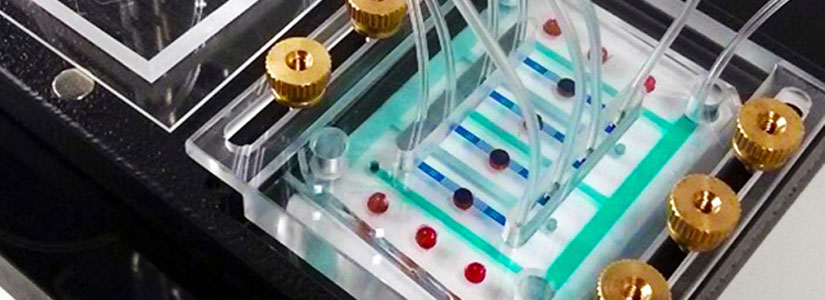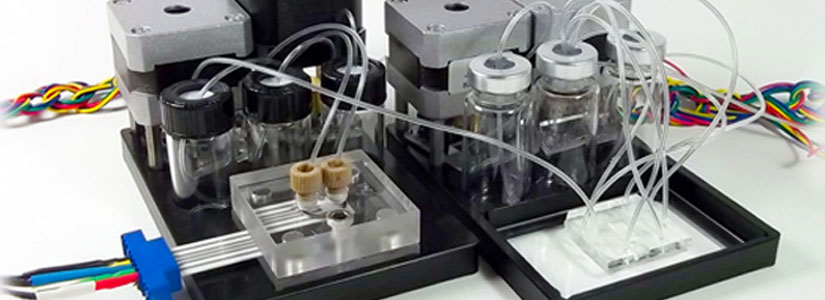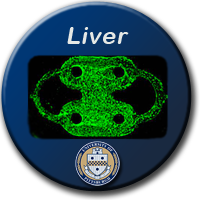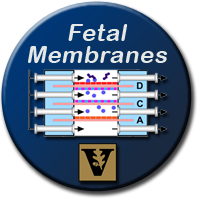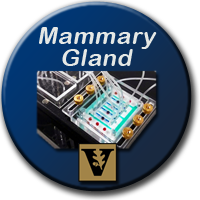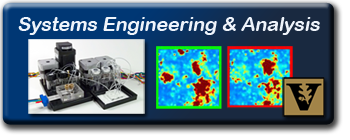The Vanderbilt-Pittsburgh Resource for Organotypic Models for Predictive Toxicology (VPROMPT) is a collaboration among researchers at the Vanderbilt University and the University of Pittsburgh Drug Discovery Institute (UPDDI). We are an EPA STAR Center (#83573601) whose mission is the development of new methods for testing chemicals for potential toxicity.
Rigorous toxicity testing data is only available for about 10% of the tens of thousands of chemicals in common use because the current “gold standard” method of animal studies is expensive, time-consuming, and raises ethical concerns. Worse yet, it is also not clearly predictive of a chemical’s ability to adversely impact human health. Alternatives have been tried based on conventional cell culture – using a single human cell type growing in a single monolayer on a hard plastic surface – but these culture models are poorly predictive of what happens in the human body. Limited predictivity has been achieved by computationally combining the results of large sets of in vitro assays (e.g., ToxCast), but we still have much to learn.
We are thus developing organotypic culture models (OCMs) – sometimes referred to as organ-on-a-chip technologies – that depart from traditional cell culture to grow multiple human cell types in 3D arrangements with carefully controlled microfluidic perfusion. All of these improvements are designed to more accurately reproduce the microenvironment experienced by cells in living human organs. There are indications that such microenvironments enable cells in OCMs to respond to stimuli (noxious and otherwise) much more like they do in vivo.
Our three center-wide objectives are:
- to use OCMs to identify the scale(s) of organismal complexity that most severely confound predictions of in vivo toxicity from in vitro data sets;
- to use OCMs to elucidate the details of selected Adverse Outcome Pathways (AOPs) from molecular initiating events to tissue-level responses; and
- to engineer and develop OCM platforms and control systems that will be amenable and affordable for mid- to high-throughput chemical screening.
We will address these objectives through five primary projects. Four of the projects are for development of specific culture models – a liver-OCM plus three OCMs relevant to developmental and reproductive toxicology: mammary gland, limb/joint development, and fetal membrane. The fifth project focuses on engineering the platforms needed to robustly grow, couple, and assess these cultures in ways that will be amenable to high-content, mid-throughput screening. The links below offer more information on each project.
- Project 1. Mammosphere Bioreactor For Life-Stage Specific Toxicology
- Project 2. Organotypic Culture Model to Analyze Developmental Limb Malformations Resulting from Toxicant/Teratogen Exposure
- Project 3. Validating a Fetal Membrane-on-a-Chip Model for Characterizing Reproductive Toxicant Exposure Risks
- Project 4. Organotypic Liver Model for Predictive Human Toxicology and Metabolism
- Project 5. Systems Engineering & Analysis for Organotypic Culture Models
Supported in part by EPA STAR Center Grant 83573601, VIIBRE (J.W.), NIH 1UH2-TR000491-01, DARPA W911NF-12-2-0036, DTRA100271A-5196, NIH/NIEHS RO1 ES010563 , NIH/NIEHS RO1 ES016931, Department of Defense Breast Cancer Research Program (DOD BCRP) grant W81XWH-10-1-0157 (to L.J.M.).
This website has not been formally reviewed by EPA. The views expressed are solely those of the authors and do not necessarily reflect those of the Agency. EPA does not endorse any products or commercial services mentioned herein.


